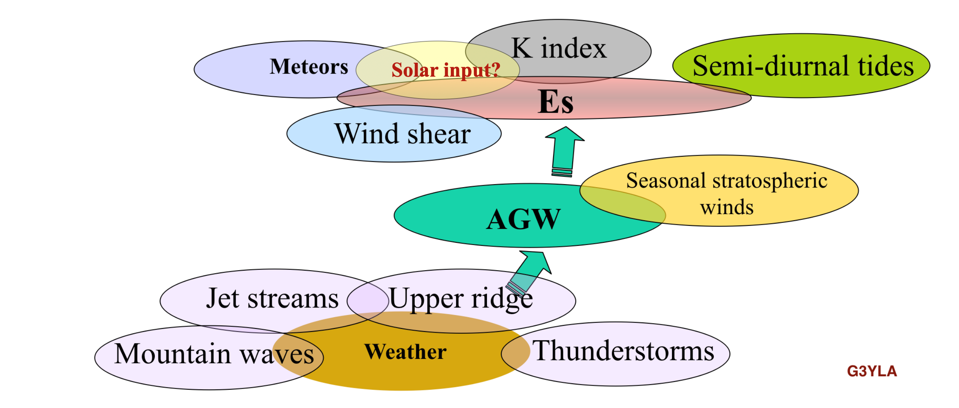The plots are designed to show the near real-time evolution of the critical frequency ( foF2 ) of the F2 layer and (foEs) for Sporadic-E as measured by the international network of ionosondes. The display system is set up to process data from the USAF ionosonde at RAF Fairford in Gloucestershire on the Cotswolds and from the Rutherford Appleton Laboratory at Chilton in Oxfordshire and Dourbes in Belgium run by the Royal Meteorological Institute of Belgium.
These data are automatically decoded from ionograms and where conditions do not allow a value to be determined automatically, a gap appears in the graph. The displays depend upon the data being uploaded from the measurement station and therefore depends upon many operational factors outside our control. Outages are usually of short duration, so keep checking periodically if data is missing. Data can be accessed from whichever ionosonde (Fairford, Chilton or Dourbes) is available, although the page opens with Chilton as default. The hover-over tool tip will tell you which ionosonde the data point belongs to and the data values.
The purpose of these graphs is to allow radio amateurs to use this professional ionosonde data to improve their understanding of radio propagation conditions heard on the air in relation to actual measured conditions of the ionosphere, as they happen.
TODAY
This graph shows a series of traces, which can be toggled off and on by clicking the label on the key for each line. The graph redraws as elements are changed to give maximum clarity of display. A tool tip showing the value of each data point appears if you hover over any of the lines plotted.
- foF2 : critical frequency of the F2 layer (plotted in red with dots as data points)
- 100km F2 MUF : critical frequency of the F2 layer for a 100km path
- 500km F2 MUF : critical frequency of the F2 layer for a 500km path
- 1000km F2 MUF : critical frequency of the F2 layer for a 1000km path
- 3000km F2 MUF : critical frequency of the F2 layer for a 3000km path
- foEs : critical frequency of Es (plotted purple, where measurements available)
- The operating frequencies of the amateur bands are shown as dotted green lines.
- The times of sunrise/set (at ground level) are shown by the yellow band.
A PDF or PNG can be produced by selecting the three sheets of paper symbol on the top right.
The F2 MUF lines are plotted in increasingly orange shade as the distance increases. If you hover your mouse over a line it becomes bold and shows a tool tip which which gives the actual value of the various elements.
Data is received shortly after the nominal observation time, and the delay can vary from as little as 10minutes to an hour or two, depending upon processing and data transfer within the ionosonde network. The display will plot the latest data when you first log in, you will need to refresh manually to bring in the latest reading subsequently.
ARCHIVE
This page recreates a daily plot of foF2, F2 MUF and foEs for any date going back to December 2016. Obviously, there will be times when data is missing, but most dates are available. The plots are exactly the same as the TODAY display, so refer to the instructions above for details.
NVIS
This is a relatively new section to enable the Spread F Index (fxI) to be plotted and compared with the foF2 and foEs. These three parameters of an ionosonde represent three frequencies that are very important for local nets on the LF bands. Providing at least one of these three frequencies is above the band frequency you are working then you should be able to hear each other. Hitherto, amateurs have tended to regard foF2 as the only indicator of importance, but signals can still be received via spread F, hence the value of plotting the fxI too, which is typically about 700kHz higher than the foF2. When both the foF2 and fxI are below the the band being worked then only long skip paths are available, unless of course you are lucky enough to find Sporadic-E, although this is usually temporary.
COMPARE
This page shows two foF2 traces, the dates of which are individually selectable. The tool tip will show the difference between the two readings. This can be a very useful resource if you want to compare band conditions during recent club nets, or compare the performance of your station or club in the last two RSGB 80mCC contests. The 80mCC are particularly vulnerable early in the year.
AVERAGES
This section shows the monthly averaged hourly foF2 and the maximum foEs by hour. I expect this will show some interesting changes as the solar cycle evolves so take note of the smoothed sunspot number (SSN).

